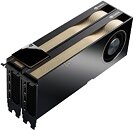
2.1 Billion Pixels in Las Vegas Sphere are Powered by 150 NVIDIA RTX A6000 GPUs
The city of Las Vegas late last year added another attraction to its town: the Sphere. The Sphere is a 1.2 million pixel outdoor display venue famous for its massive size and inner 18,600-seat auditorium. The auditorium space is a feat of its own with features like a 16x16 resolution wraparound interior LED screen, speakers with beamforming and wave field synthesis technologies, and 4D physical effects. However, we have recently found out that NVIDIA GPUs power the Sphere. And not only a handful of them, as 150 NVIDIA RTX A6000 power the Sphere and its 1.2 million outside pixels spread on 54,000 m², as well as 16 of 16K inner displays with a total output of 2.1 billion pixels. Interestingly, the 150 NVIDIA RTX A6000 have a combined output cable number of 600 DisplayPort 1.4a ports.
With each card having 48 GB of memory, that equals to 7.2 TB of GDDR6 ECC memory in the total system. With the Sphere being a $2.3 billion project, it is expected to have an infotainment system capable of driving the massive venue. And it certainly delivers on that. Only a handful of cards powers most massive media projects, but this scale is something we see for the first time in non-AI processing systems. The only scale we are used to today is massive thousand-GPU clusters used for AI processing, so seeing a different and interesting application is refreshing.
With each card having 48 GB of memory, that equals to 7.2 TB of GDDR6 ECC memory in the total system. With the Sphere being a $2.3 billion project, it is expected to have an infotainment system capable of driving the massive venue. And it certainly delivers on that. Only a handful of cards powers most massive media projects, but this scale is something we see for the first time in non-AI processing systems. The only scale we are used to today is massive thousand-GPU clusters used for AI processing, so seeing a different and interesting application is refreshing.




















